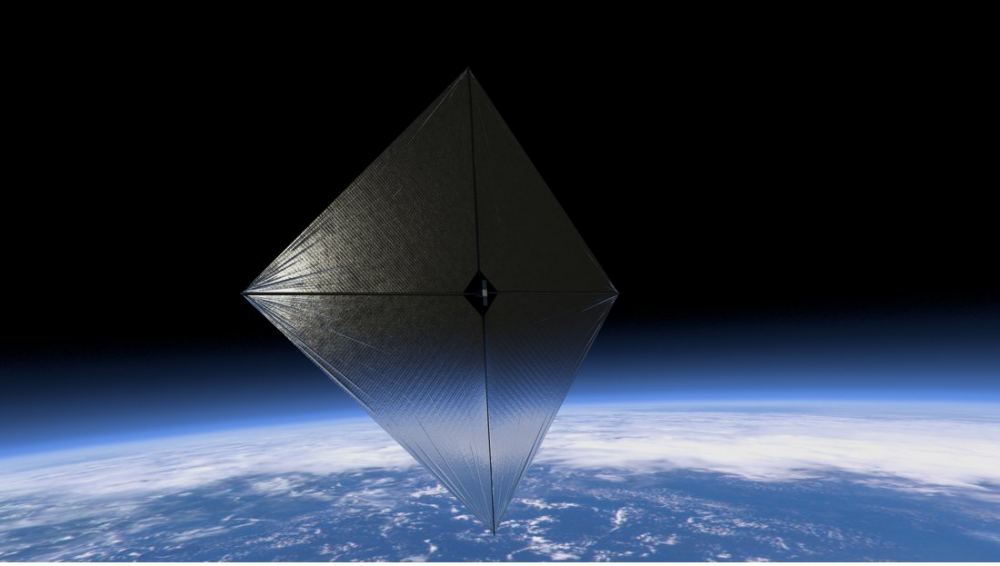It probably comes as no surprise to people suffering through drastic weather this year that our planet is heating up. Climate change is the culprit and researchers continue to look for ways to mitigate its effects. A scientist at the University of Hawai’i suggests a novel approach: create a giant solar shade in space to block enough sunlight to counter climate change.
Sure, it sounds like science fiction, but there’s some solid science behind the idea. The concept first appeared in the early 1920s as a method of climate engineering. In recent years, engineers have proposed sunshades and solar sails as multipurpose technology to shade one part of Earth while also providing a way to capture sunlight for solar power.
According to astronomer István Szapudi, tethering a sunshade to an asteroid is a workable design suitable for development within the decade. It’s based on everyday experience. “In Hawai’i, many use an umbrella to block the sunlight as they walk about during the day,” said Szapudi. “I was thinking, could we do the same for Earth and thereby mitigate the impending catastrophe of climate change?”
The Theory Behind the Sunshade
Making a sunshade big enough to do an effective job requires a fairly massive installation. It has to balance gravitational forces at the same time it has to resist solar radiation pressure. Essentially, Szapudi sees a shield made of lightweight materials tethered to a massive counterweight (i.e. an asteroid).

In the system Szapudi describes, the counterbalance would “ride along” the sunward side of the shield. The mass of the asteroid would help reduce the weight and mass of the shield itself. The system would then operate to reduce solar radiation by 1.7%. Theoretically this is about what you’d need to avoid a catastrophic rise in global temperatures.
In Szapudi’s paper, the system is called a Solar Radiation Management (SRM) system. It’s “home base” would be at an L1 Lagrange point. The author also suggests that for reasons of stability, an alternatue approach could use several smaller shields rather than a single large one. A substructure would connect the individual shields and the asteroid counterweight. The paper also describes maintaining stability of the whole structure as well as fuel-free orbital maintenance.
Practical Challenges to the Theory
While this sounds like an interesting approach to reducing solar radiation, there are some problems with the system. Even using lightweight materials for the sunshade is great. But, it will still weigh about 3.5 million tons. That’s an issue because current launch capabilities only allow about 35,000 tons. So, it’s likely that any future designs will require even lighter materials to make such a system launch-viable.
Luckily, the counterweight doesn’t have to be launched, since it’s an asteroid. The challenge there is to locate and move a target asteroid to a stable orbit so that work crews can attach the sunshade. There are a couple of ways to do this. One is to rely on a ballistically captured one snared into orbit around Earth naturally. That relies on finding one in the right orbit. The other way is to use some kind of artifically applied force to move the asteroid where it’s needed.

Another main challenge is the existence of sufficiently strong tether materials. Think of the “space elevator” idea but with long-enough tethers to attach sunshades and counterweights. Luckily, the technologies needed for both the tethers and sunshield aren’t all that far in the future. For example, graphene for the shield is steadily becoming more affordable. These days, it’s about $100 a square meter, but in ten years could be had for as little as $1/square meter. Similarly, launch costs will continue to become more affordable, perhaps to a few tens of dollars per kilogram.
When Do We Get a Sunshade?
The author suggests in the paper that a tethered shield could be readily available soon. Szapudi writes, “Depending on the parallel and intertwined development of graphene, tether, and orbital technologies, a tethered shield might initially be faster and cheaper to realize than a heavier structure satisfying the McInnes bound. Nevertheless, the latter might eventually serve as a solar energy source for Earth or solar system exploration.”
The actual building and deployment of a system like Szapudi’s really requires that people start the R&D now. Of course, it’s not a complete panacea for the all effects of climate change. But, as the author points out, it could serve as more of an “insurance policy” that can be deployed if other methods of mitigating climate change fail.
For More Information
Sun “Umbrella” Tethered to Asteroid Might Help Mitigate Climate Change
Solar Radiation Management with a Tethered Sun Shield
Space sunshade (Wikipedia)


Brilliant!! So we’ve all got to pay hundreds of billions to mitigate climate change because big oil won’t live up to it’s responsibilities or change it’s business model.
Where we live we get poor levels of sunshine as well so nice for all those arab and texan oil well owners who have plenty of sun but we here on Dartmoor in England will get even less and what about the poor photosynthetic alagae where the world gets most of its oxygen from.
Cockamamie scheme.